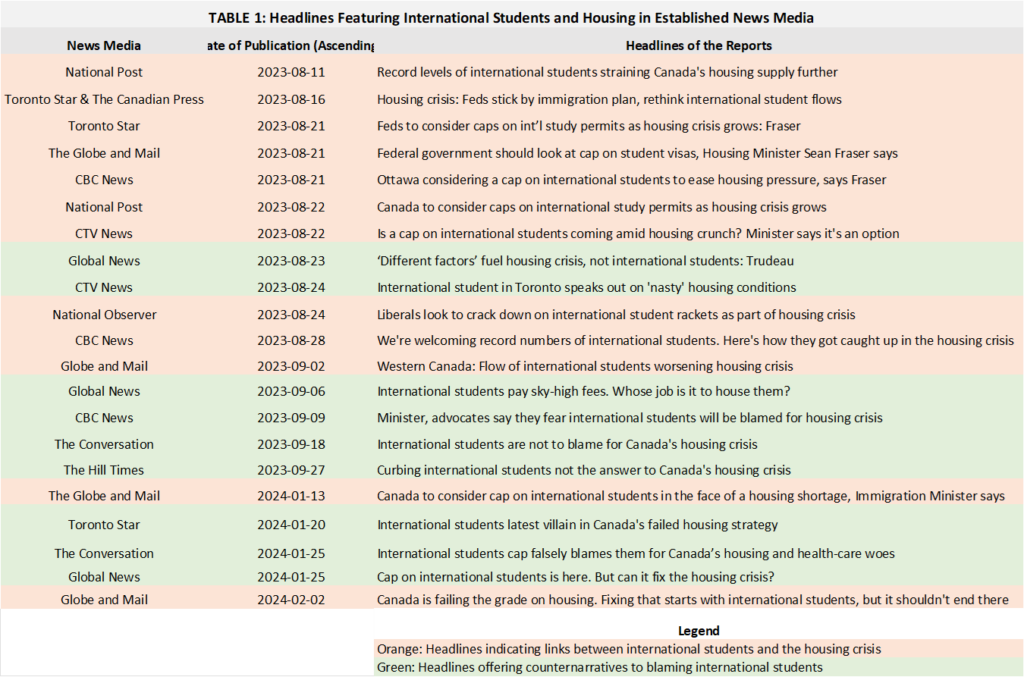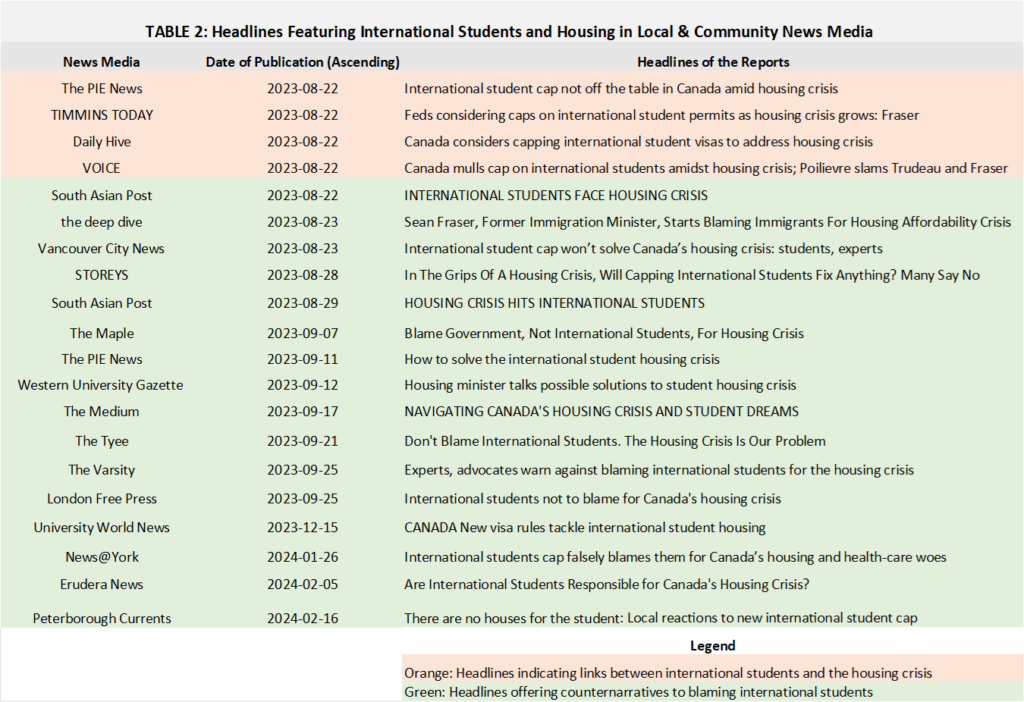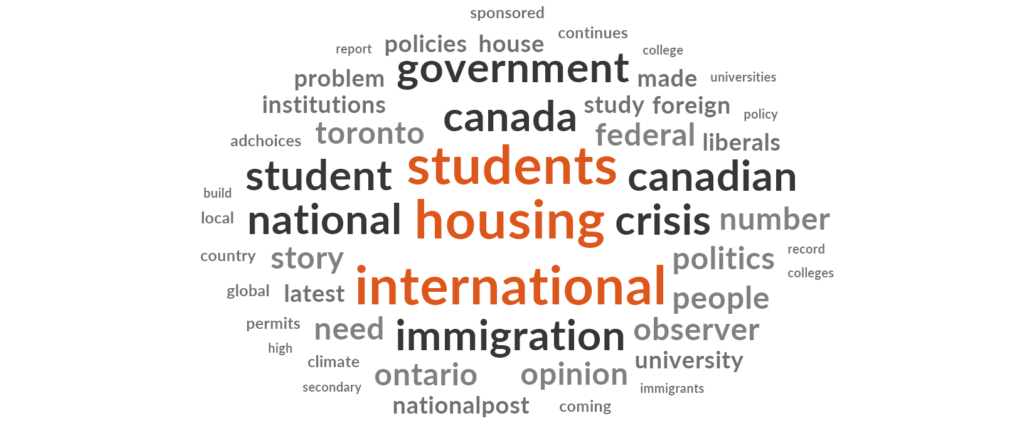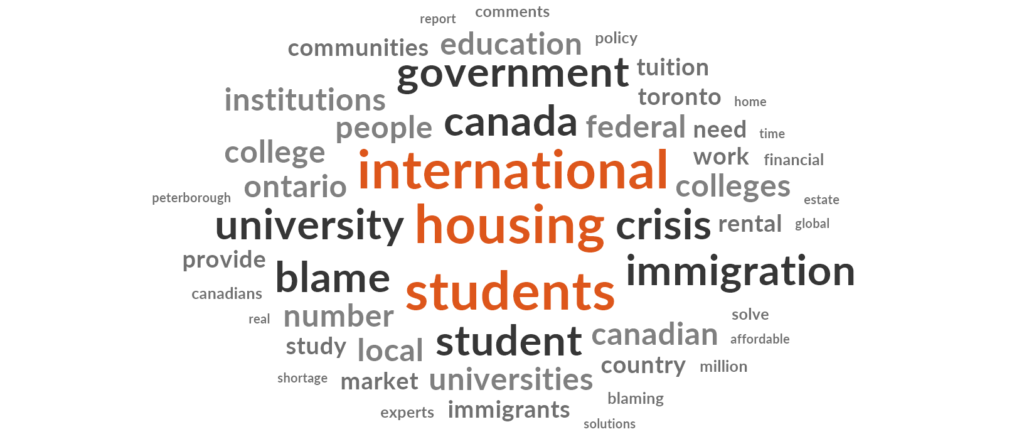BACKGROUND
Since August 2023, there has been a surge in news reports linking Canada’s housing crisis with the increasing number of international students, making this topic a key issue of public debate. The notion that the growing number of international students is the main reason for the housing crisis in Canada and that a cap on their number could solve the problem has been widely circulated in Canadian news media. This idea gained traction when Housing, Infrastructure, and Communities Minister Sean Fraser suggested on August 21, 2023, that the admission of a record number of immigrants, particularly international students, is a key factor behind the housing crisis. The conundrum lies in the fact that Fraser himself was responsible for the admission of permanent and temporary residents during his tenure as Immigration Minister from October 26, 2021, to July 26, 2023, yet he did not foresee the link between housing and immigration during his time in that role.
Amid Minister Sean Fraser’s comment about the impact of the growing number of international students on the housing market, current Immigration Minister Marc Miller announced that the federal government would implement a cap on the number of student permits over the next two years. On January 22, 2024, the official announcement regarding the cap on international students was released. The announcement emphasized that some institutions have significantly increased their intakes to boost revenues, resulting in more students arriving in Canada without the necessary support to succeed. It also stated that “rapid increases in the number of international students arriving in Canada put pressure on housing, health care, and other services,” to justify the cap. For 2024, the cap is expected to result in approximately 360,000 approved study permits, a decrease of 35% from 2023. The extent to which this cap will solve the housing problem will become clear in the coming months.
Noteworthy is the media’s role in generating narratives and counter-narratives regarding the role of international students in the housing crisis, making this vulnerable group with temporary status the center of discourse. Analysis of news reports (both headlines and content) published between August 2023 and February 2024 found that some reports blamed international students or directly and indirectly linked them to the housing shortage, influencing anti-international student sentiments among the public. Conversely, other reports criticized the cap on international students, arguing it underscores a reactive approach to the housing crisis rather than addressing the broader systemic issues contributing to the shortage of affordable housing, particularly for students.
These reports revolved around the question: Are international students villains or victims of the housing crisis? This question itself presents a polarized perspective, influencing the public to adopt an either/or approach rather than fostering a balanced understanding of the interconnected and distinct issues related to the housing shortage and the integrity of postsecondary institutions that rely on international students for revenue. Moreover, local and community-based news media have been more vocal in criticizing the link between international students and the housing crisis, whereas established news media, despite their wider audience and greater influence, often lack a critical perspective.
RESEARCH: SCOPE AND METHODS
Total of 41 news reports published in 28 news media platforms were selected for the study. The news media platforms are divided into two groups: 1) established news media and 2) local and community news media. For instance, established news media like the Toronto Star or National Post have a broad readership and significant influence over public discourse, often setting the agenda for national conversations. In contrast, local and community-based news outlets like South Asian Post or News@York focus on specific communities or sectors. They provide in-depth coverage and analysis of issues relevant to their audiences. These smaller outlets can offer unique perspectives and critical insights that may not be as prominent in larger, more generalized media coverage.
Total of 10 established news media outlets were included: Toronto Star, The Canadian Press, National Post, The Globe and Mail, CBC News, CTV News, Global News, National Observer, The Hill Times and The Conversation. The study also selected 18 local and community news media outlets: The PIE News, Timmins Today, Daily Hive, VOICE, South Asian Post, The Deep Dive, Vancouver City News, Storeys, The Maple, Western University Gazette, The Medium, The Tyee, The Varsity, London Free Press, University World News, News@York, Erudera News, and Peterborough Currents.
The reports from these media outlets were selected based on headlines containing “international students” and “housing” or “international study permits” and “housing.” The study focused on reports that directly addressed the intersection of international students/study permits and housing, providing insights into how the presence of international students is linked to the housing crisis and how this issue is portrayed across different media platforms. Reports published between August 2023 and February 2024 were included, a period during which this topic was prominent due to policy changes and heightened media focus.
Using NVivo, the analysis comprised three main steps: headline analysis, content analysis, and thematic analysis. The headline analysis aimed to identify the primary messages that capture the audience’s attention and leave a lasting impression. Content analysis focused on determining the frequency of specific words and terms to elucidate the report’s main focus. Thematic analysis involved a comprehensive examination of the themes present in the reports, encompassing information, data, facts, expert opinions, and overall arguments to assess their alignment with the identified headlines.
ANALYSIS OF HEADLINES: ESTABLISHED NEWS MEDIA
Blaming/Linking International Students for Housing Crisis
Established news media began highlighting the link between international students and Canada’s housing crisis in mid-August 2023. This trend surged after August 21, when the former Immigration Minister (Sean Fraser) directly attributed the housing crisis to the increasing number of international students. Consequently, the current Immigration Minister (Marc Miller) mentioned the possibility of capping the number of international students. Throughout August and early September in 2023, many news outlets, including Toronto Star, The Globe and Mail, CBC News, National Post, and National Observer prominently featured both ministers’ statements in their headlines (see Table 1). Notable examples include:
- Toronto Star (2023-08-21): “Feds to consider caps on int’l study permits as housing crisis grows: Fraser”
- The Globe and Mail (2023-08-21): “Federal government should look at cap on student visas, Housing Minister Sean Fraser says”
- CBC News (2023-08-21): “Ottawa considering a cap on international students to ease housing pressure, says Fraser”
- CTV News (2023-08-22): “Is a cap on international students coming amid housing crunch? Minister says it’s an option”
Some headlines even blamed international students for the housing crisis. For example:
- National Post (2023-08-11): “Record levels of international students straining Canada’s housing supply further”
- Globe and Mail (2023-09-02): “Western Canada: Flow of international students worsening housing crisis”
These headlines imply that international students are a major factor exacerbating the housing crisis, creating a narrative that directly associates them with housing shortages and affordability issues.

Although some news media headlines did not explicitly blame international students for the housing crisis, they implied a link:
- National Observer (2023-08-24): “Liberals look to crack down on international student rackets as part of housing crisis”
- National Post (2023-08-22): “Canada to consider caps on international study permits as housing crisis grows”
- CBC News (2023-08-28): “We’re welcoming record numbers of international students. Here’s how they got caught up in the housing crisis”
The direct connections, while not damaging but suggestive that somehow international students are a key component of housing shortage. These headlines were impactful in influencing public opinion by emphasizing the negative impact of international students without considering their contributions to the economy, society, and education sector.
Counter Narratives
In August 2023, only two headlines offered counter-narratives. One, by Global News, featured Trudeau’s statement defending international students as a means of damage control. The other, by CTV News, highlighted the struggles international students face with housing conditions:
- Global News (2023-08-23): “‘Different factors’ fuel housing crisis, not international students: Trudeau”
- CTV News (2023-08-24): “International student in Toronto speaks out on ‘nasty’ housing conditions”
More counter-narratives appeared in headlines published in September 2023. These headlines highlighted how international students are not the primary cause of the housing crisis and how they themselves face challenges in accessing affordable housing:
- Global News (2023-09-06): “International students pay sky-high fees. Whose job is it to house them?”
- The Hill Times (2023-09-27): “Curbing international students not the answer to Canada’s housing crisis”
- The Conversation (2023-09-18): “International students are not to blame for Canada’s housing crisis”
In late January 2024, before and after the IRCC announcement on the cap for international students (Jan 22, 2024), several established news media headlines explicitly criticized the linkage between international students and the housing crisis, such as:
- Toronto Star (2024-01-20): “International students latest villain in Canada’s failed housing strategy”
- The Conversation (2024-01-25): “International students cap falsely blames them for Canada’s housing and health-care woes”
The move from blaming international students for the housing crisis to recognizing the complexities of the issue and the role of government policies is a positive development. However, initial media narratives that connected international students to housing shortages have had a lasting impact on public sentiment. Negative sentiments towards international students are evident on public platforms such as Reddit and in public polls, where discussions and opinions often echo these early, misleading narratives. For example, an Ipsos poll conducted for Global News, reported on October 6, 2023, found that most Canadians support caps on immigration and international students amid the housing crisis. The poll revealed that the growing housing crisis led a significant portion of Canadians to consider solutions they may have previously resisted, such as imposing caps on immigration and international students, as well as increasing housing density.
ANALYSIS OF HEADLINES: LOCAL AND COMMUNITY NEWS MEDIA
The local and community-oriented media played a prominent role in countering and criticizing the blame placed on international students for housing affordability issues. On August 22, several media outlets, including The PIE News, Daily Hive, Timmins Today, and VOICE, featured statements from the former immigration minister suggesting that controlling the number of international students could be a potential solution to the housing issue. While these headlines did not directly blame international students, they mirrored the headlines of established media by presenting a link between the housing crisis and international students (see Table 2).

However, immediately after August 22, headlines began explicitly deflecting blame from international students and attributing the housing crisis to government actions or inactions. Many headlines directly counter the notion that international students are to blame and instead placed the blame on the government. Some reports highlighted expert opinions advising against blaming international students and emphasized the need to address the root causes of the housing crisis through comprehensive policy changes. Notable examples include:
- Vancouver City News (2023-08-23): “International student cap won’t solve Canada’s housing crisis: students, experts”
- The Tyee (2023-09-21): “Don’t Blame International Students. The Housing Crisis Is Our Problem”
- The Maple (2023-09-07): “Blame Government, Not International Students, For Housing Crisis”
- The Varsity (2023-09-25): “Experts, advocates warn against blaming international students for the housing crisis”
- London Free Press (2023-09-25): “International students not to blame for Canada’s housing crisis”
- News@York (2024-01-26): “International students cap falsely blames them for Canada’s housing and health-care woes”
A few headlines also focused on how the housing market affects international students, implying they are victims rather than contributors to the crisis:
- The PIE News (2023-09-11): “How to solve the international student housing crisis”
- South Asian Post (2023-08-29): “Housing crisis hits international students”
- Peterborough Currents (2024-02-16): “There are no houses for the students: Local reactions to new international student cap”
Overall, from August 2023 to February 2024, local and community news media emphasized the broader impacts of the housing crisis on students without specifically blaming international students. Instead, they focused on solutions, adopting a more proactive and positive approach. These outlets considered the various contexts of the housing crisis and its effects on students’ aspirations, while highlighting the unique challenges faced by international students.
CONTENT ANALYSIS: ESTABLISHED VS LOCAL AND COMMUNITY MEDIA
Word Frequency Analysis
The word clouds from “Established Media” and “Local and Community Media” sources exhibit both similarities and differences in their portrayal of the housing crisis and the role of international students.
Similarities:
- Key Terms: Both word clouds prominently feature terms such as “international,” “students,” “housing,” “crisis,” “immigration,” “government,” and “Canadian.” This indicates a shared focus on the same core issues across both types of media.
- Context: Both word clouds suggest a discussion around the role of international students in the housing crisis, highlighting the intersection of student numbers, housing availability, and immigration policies.
Word Clouds


Differences:
- Emphasis on Blame:
- Established News Media: The word cloud includes terms like “national,” “Toronto,” “liberals,” and “federal,” indicating a focus on the broader political and national context. This suggests that larger media outlets may discuss the issue within a more political and systemic framework.
- Local and Community News Media: The word cloud includes the term “blame” more prominently, indicating a more direct critique of attributing the housing crisis to international students. Terms like “local” and “communities” also appear, suggesting a more grassroots perspective.
- Policy and Institutional Focus:
- Established News Media: Terms like “policies,” “institutions,” “universities,” and “federal” suggest discussions around broader policy implications and institutional roles in the housing crisis.
- Local and Community News Media: Terms such as “college,” “provide,” “education,” and “tuition” imply a more focused discussion on the educational institutions and their immediate impacts on housing.
- Regional vs. National Focus:
- Established News Media: The inclusion of terms like “Canada,” “federal,” and “national” indicates a nationwide perspective.
- Local and Community News Media: The presence of terms like “Toronto,” “Ontario,” and “local” suggests a more regional or local focus on the issue.
- Economic and Social Aspects:
- Established News Media: The word cloud features terms like “economic,” “number,” and “impact,” pointing to a broader economic analysis.
- Local and Community News Media: Terms such as “blame,” “communities,” and “provide” indicate a focus on social implications and community-level impacts.
While both established and local and community media reports cover the housing crisis and the role of international students, established media tend to frame the issue within a broader, national, and political context, emphasizing policy and institutional roles. In contrast, local and community media focus more on the direct impacts on local communities and are more critical of blaming international students for the housing crisis. This suggests that local and community media may provide a more nuanced and community-focused perspective compared to the broader, more systemic approach of established media.
THEMATIC ANALYSIS
Thematic analysis of reports from both established and local and community news media reveals several key similarities and differences in their focus on the housing crisis and the role of international students.
Reports Linking International Students to the Housing Crisis
Reports that linked international students to the housing crisis in both types of media focused on several key themes:
- Strain on the Housing Market: These reports highlighted how the rapid increase in the number of international students, as noted by former and current Ministers of Immigration, Refugees, and Citizenship Canada, Sean Fraser and Marc Miller respectively, has contributed to the pressure on housing, healthcare, and other services.
- Overcrowding in Rental Markets: Many reports emphasized how the influx of international students has led to overcrowding in rental markets, driving up rental prices and reducing availability for local residents.
Additionally, the established news media emphasized:
- Impact on Urban Centers: Articles frequently discussed the concentration of international students in major urban centers, exacerbating housing shortages in these already high-demand areas.
- Resource Allocation: Some reports pointed out that the increased demand for housing from international students has diverted resources away from other crucial areas, leading to a strain on public services and infrastructure.
- Economic Disparities: There was also mention of the economic disparities created by the housing demand, where international students, often able to pay higher rents, inadvertently contribute to the rising costs of living, making it difficult for lower-income local residents to find affordable housing.
Reports Criticizing the Blame on International Students
Reports published in both types of media that criticized linking or blaming international students for the housing crisis focused on several key themes:
- Broader Factors Contributing to the Housing Crisis: These reports emphasized systemic issues such as underfunding of post-secondary institutions, reliance on higher tuition fees from international students, and regulatory failures.
- Scapegoating and Systemic Failures: Articles argued that international students are unfairly blamed, with the real issues lying in systemic failures in housing policy, government planning, and poor urban planning.
Additionally, the local and community news media emphasized:
- Government and Institutional Responses: Reports discussed the government’s consideration of capping international student visas and the opposition from universities, highlighting the symbolic and discriminatory nature of such measures and advocating for increased housing supply.
- Empathy and Support for International Students: Reports underscored the challenges international students face, exacerbated by bad faith programs, fraudulent agents, mental health issues, and policy uncertainties. They called for increased support and better funding for educational institutions.
- Recommendations and Solutions: Experts called for collaboration between universities, local governments, and developers, streamlining development processes, reducing regulatory barriers, and investing in student accommodations as essential steps.
The thematic analysis indicates that both established and local and community media share similarities in their coverage of the housing crisis, particularly when focusing on themes like the the growing number of international students, strain on the housing market and overcrowding in rental markets. However, established media tend to emphasize broader systemic impacts such as resource allocation and economic disparities, while local and community media provide more critical perspectives on government responses and the need for empathy and support for international students.
CONCLUSION
The analysis of media headlines and content of reports published from August 2023 to February 2024 reveals a polarized narrative surrounding the role of international students in Canada’s housing crisis. Initial reports were quick to link international students to housing issues, often portraying them as a significant factor exacerbating the crisis. However, subsequent coverage increasingly acknowledged the systemic nature of the problem and emphasized the importance of collaborative, long-term solutions. This evolving narrative influenced and divided public sentiment, depicting international students as either villains or victims of the housing crisis, and potentially diverting attention from the broader systemic issues at play.
Some established news media (National Post, Toronto Star, The Canadian Press, The Globe and Mail, CTV News, National Observer) initially blamed/linked international students for housing shortages, driven largely by statements from political figures. This narrative often suggested that the growing number of international students were a significant factor in exacerbating housing issues, creating a one-dimensional perspective that failed to consider the multifaceted nature of the crisis. Over time, the narrative in established media (Global News, National Post, CBC News, The Conversation, The Hill Times, Toronto Star) shifted towards broader systemic issues and governmental policies (Table 1).
Most local media (such as Vancouver City News, South Asian Post, the Maple, The PIE News, The Tyee, The Varsity, London Free Press and New@York) played a prominent role in offering a more critical viewpoint by countering the blame on international students and highlighting the broader context of the housing crisis (Table 2). These reports emphasized failures in government policies, regulatory inadequacies, and the chronic underfunding of post-secondary institutions that have led to the current housing challenges. By focusing on expert opinions and advocating for comprehensive policy changes, these media outlets underscored the need to address the root causes of the crisis rather than scapegoating international students. This approach fostered a more nuanced public discourse, promoting empathy and support for international students who are also victims of the housing crisis.
Ultimately, the evolution of media narratives over time indicates a shift towards recognizing the complexities of the housing crisis and the role of government policies. This progression highlights the critical role of media in shaping public opinion and the necessity of informed, balanced reporting to foster a comprehensive understanding of socio-economic challenges. However, considering how some established news media highlighted the link between international students and the housing crisis, one must ask: To what extent have they contributed to public misconceptions about international students being the root cause of the housing crisis?



